MXA MOTOCROSS RACE TEST: 2018 SUZUKI RM-Z250
Q: FIRST AND FOREMOST, IS THE 2018 SUZUKI RM-Z250 BETTER THAN THE 2017 RM-Z250?
A: We have to applaud Suzuki for at least changing the graphics on the bike and adding blue accents. Some manufacturers don’t even put BNG (bold new graphics) on its unchanged models. For Suzuki, this is the only applause they will get for 2018. The rest of the bike is unchanged. It is not better than last year, or the year before, or even the year before that. Why? Because in 2016 Suzuki decided to make its RM-Z250 slower than the 2015 model. That’s right. The 2015 RM-Z250 cleared 39 ponies, while the 2016, 2017 and 2018 models made 38.35 horsepower. The 2018 Suzuki RM-Z250 is the slowest and heaviest bike in the 250 class. Having said that, this is a fun bike that is great for entry-level riders.
The 2018 Suzuki RM-Z250 is the slowest and heaviest bike in the 250 class. Having said that, this is a fun bike that is great for entry-level riders.
Q: WHAT DOES SUZUKI NEED TO CHANGE ON THE RM-Z250 FOR 2019?
A: We are speculating that Suzuki will come out with a new RM-Z250 for 2019 that resembles the updated 2018 RM-Z450. But, let’s hope they do a better job with the 2019 Suzuki RM-Z250 than they did with the 2018 RM-Z450. This year the RM-Z450 has a confused chassis that is not made for high speeds. And, although the RM-Z450 engine has a smoother powerband and revs further, it produces the identical power that it produced last year. The Suzuki RM-Z450 has had the same power and curve for 10 years running. On the positive side, we do like the 2018 Suzuki RM-Z450’s updated looks, but looks only go so far. So, if Suzuki plans to do to the 2019 RM-Z250 what it did to the 2018 RM-Z450, we hope Suzuki does a better job this time.
Five years ago the RM-Z250 finished second in the “MXA 250 Four-Stroke Shootout.” What happened in the ensuing five model years? The 2018 RM-Z250 only makes a 1/2 horsepower more than it did eight years ago, while the KTM 250SXF has gained 8 horsepower. Suzuki is in a black hole of engine R&D. Here is a quick list of what the MXA wrecking crew thinks that Suzuki needs to focus on in 2019.
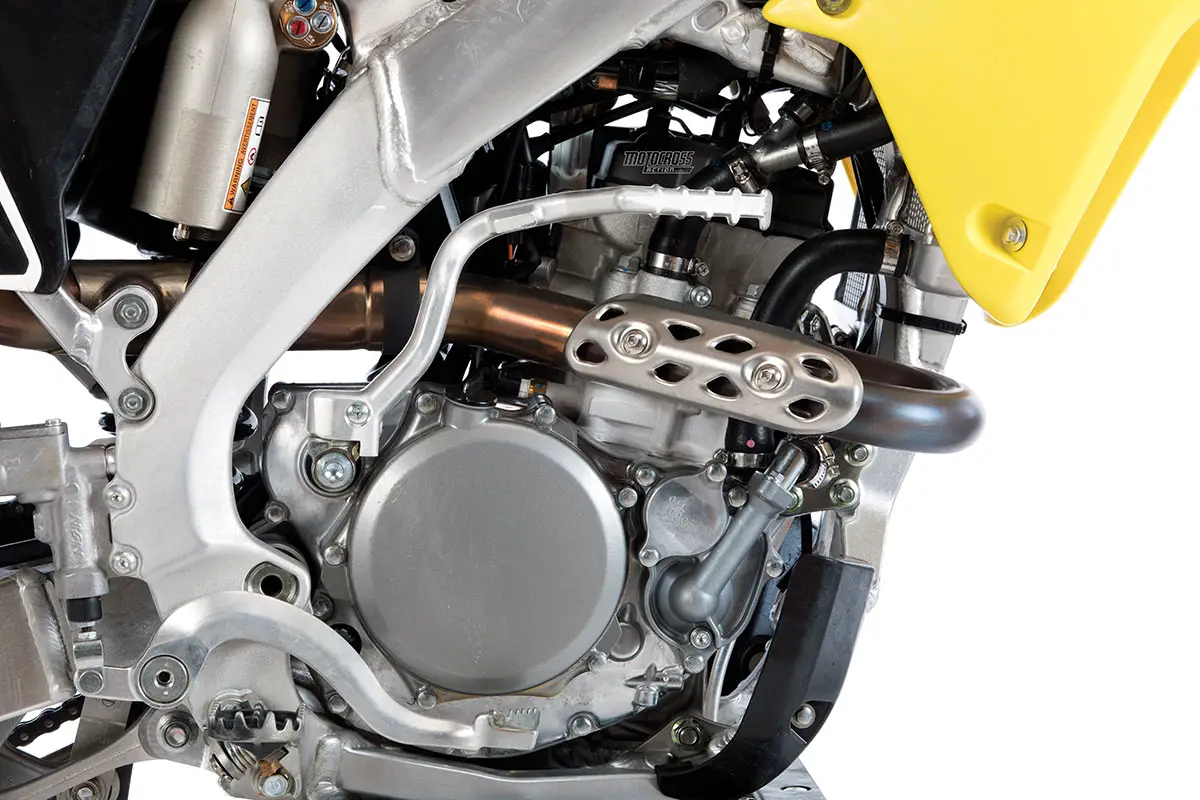 This engine is best from low to mid. It works great on the exit of corners, but once it gets moving, it has nothing left to give.
This engine is best from low to mid. It works great on the exit of corners, but once it gets moving, it has nothing left to give.
(1) Engine. The 2018 RM-Z250 engine does its best work down low. In tight corners and jumps with short runs, this engine feels like something we could live with. Although, the more you open it up, the more it lets you down. It signs off fast. We would like to run lower gearing to hack the powerband into giving the midrange the hit it needs, but lower gearing leaves you shifting in all the wrong places. We think that this is a fun engine to ride but not to race. Riding this bike feels like you are going faster than you could possibly go—and then you get passed by the green, red, white, blue and orange competition. To keep up with the other engines in stock trim, you would need to dump $5000 into the RM-Z250 powerplant.
The last time Suzuki overhauled the RM-Z250 engine was in 2016. Suzuki made an astonishing 80 small changes to the 2016 RM-Z250. Sadly, those changes only improved the power from 6000 rpm to 7000 rpm and knocked down the peak horsepower. The RM-Z250 engine needs to rev longer and hit harder to survive in the real world. That world lives above 40 horsepower, much closer to 44 horsepower.
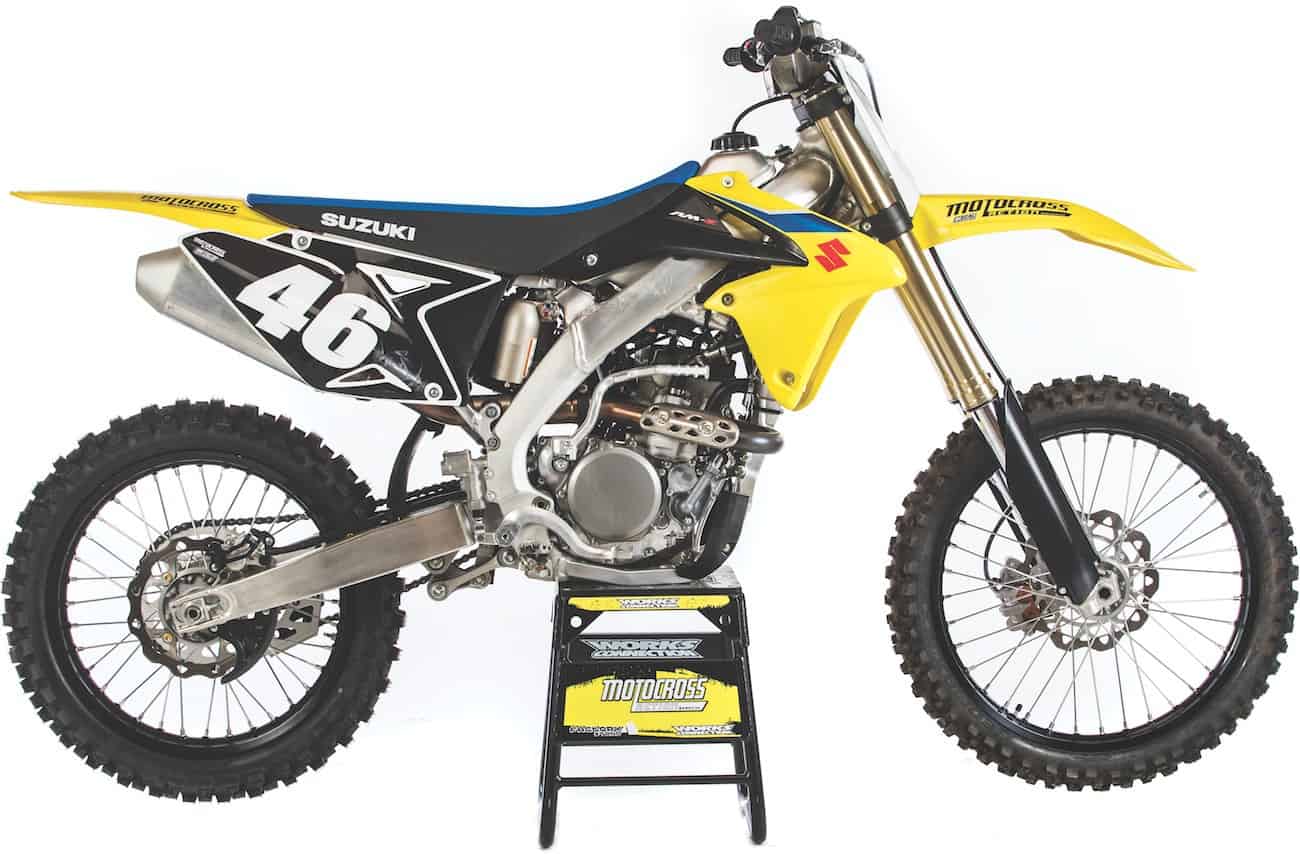 The RM-Z250 is the best-turning bike in the 250 class hands down. It makes getting through corners effortless. Sadly, this is its only superlative trait.
The RM-Z250 is the best-turning bike in the 250 class hands down. It makes getting through corners effortless. Sadly, this is its only superlative trait.
(2) Chassis. This chassis has been virtually unchanged since 2010. It is growing long in the tooth. It does have some charms, but it needs better overall balance instead of its turn-at-all-costs geometry. Suzukis turn great, but they shake at speed. They have suffered from head-shake for decades, but the Suzuki brass seems to be okay with that. If Suzuki would only give up a smidgen of its fantastic cornering and transfer it to straight-line stability, it would be a step in the right direction.
(3) Clutch. We love the easy pull at the clutch lever; however, that is where the love train stops. This clutch doesn’t last, even on a subpar engine. The least Suzuki’s engineers could do is throw RM-Z250 buyers a bone by putting stiffer clutch springs in the clutch to give it a longer lifespan. Sadly, we doubt that Suzuki’s bean counters would be willing to lose the soft pull of the lever on the showroom floor. The only clutch worse than this is the 2018 Kawasaki KX250F clutch.
(4) Brakes. The RM-Z250 brakes don’t boil and the rotors don’t get hot, but that’s because the brakes don’t work. Ten years ago this kind of pucker power would have been acceptable. Not today. The 2018 RM-Z250 is the only bike in its class that doesn’t have an oversized rotor.
(5) Looks. Riders want to buy bikes that look different from their buddies’ old models. One of the biggest reasons Suzuki sales are down is because they look the same as they did 10 years ago. Why buy a 2018 RM-Z250 when you can buy a 2010 RM-Z250 that looks exactly the same for a fraction of the price? Blue accents aren’t the answer.
Q: ARE THE KAYABA PSF-2 AIR FORKS ANY GOOD?
A: We like how the Kayaba PSF-2 forks work. We just hate adjusting them. These low-pressure air forks have a single air chamber on both forks that is adjusted via a Schrader valve. The Schrader valve is easily accessible compared to the high- and low-speed rebound damper clickers that are placed directly under the 1-1/8-inch-diameter Renthal Fat Bars. These rebound clickers are best adjusted by taking the handlebars off. We used the side of a skinny flathead screwdriver to make the painstaking rebound adjustments. The compression clickers are on the bottom of the forks.
Now that we’ve gotten how to click the clickers out of the way, let’s talk performance. The PSF-2 forks come standard at 35 psi. For most riders, 35 psi is too stiff. Most of our testers ran 32 psi and still had good bottoming resistance. If the rear sag is lower than the recommend 105mm, you will know it. We tried running lower sag to improve straight-line stability, but it created other issues. We had better luck lowering the forks in the clamps a few millimeters. When this bike is balanced, we like the Kayaba duo. It does everything above average and nothing out of the ordinary. You can always predict what the suspension will do.
Q: HOW MUCH DOES THE 2018 RM-Z250 WEIGH?
A: Without gas, the 2018 Suzuki RM-Z250 hits the MXA scales at 226 pounds. It is the second heaviest bike in the class when compared to the 218-pound KTM 250SXF, 219-pound Husqvarna FC250, 221-pound Kawasaki KX250F, 222-pound Yamaha YZ250F and 228-pound Honda CRF250. Sadly, it is heavier than the 2018 KTM 450SXF.
Q: WHAT COUPLER DID WE USE?
A: Out of the three plug-in couplers, we only ever used the white aggressive one.
Q: WHAT IS THERE TO LIKE ABOUT THE RM-Z250?
A: As racers, we have a lot of bad things to say about the 2018 Suzuki RM-Z250. We are sore losers. When we line up against the blue, white, green, red and orange competition on a yellow bike, we know we are at a disadvantage. This would be a good entry-level race bike for a rider looking for something to start out on. It is extremely easy to ride compared to the KTM 250SXF. It immediately feels comfortable. This is a bike that is suited to riders with little experience and minicycle riders graduating to the 250F class. These types of riders don’t need KTM revvability, big-pony power or bulletproof clutches. But, if you take your racing seriously, this is not the bike for you.
The best thing about this bike is the showroom deal you can make with your friendly local dealer. The RM-Z250 has some of the lowest prices in its class at dealerships. Why? Because they don’t sell, and you don’t need to buy a 2018 model since it isn’t a lot different from the 2016 or 2017 models. If you are looking for a good deal on a new bike, the RM-Z250 is the best you will find.
Q: WHAT DID WE HATE?
A: The hate list:
(1) Engine. This is an easy-to-use playful engine. It is just not competitive in the real world. It would cost a good $5000 to compete with a stock KTM 250SXF—and heaven help you if the KTM rider spent $5000 on his bike.
(2) Brakes. These are subpar brakes for a bike with a subpar engine. Given that the RM-Z250 is 8 pounds heavier than the Austrian competition, it needs extra pucker power.
(3) Clutch. The clutch is easy to pull on the showroom floor, but once you leave the linoleum, you will burn the clutch up in short order. Put stiffer springs in to offset the cost of the clutch plates.
(4) Launch control. This is a dummy switch. You will never need this, especially on a bike this mellow. Spinning the rear tire on a bike this slow is a plus.
(5) Fork adjusters. The rebound fork adjusters are mounted directly under the Renthal 1-1/8-inch FatBars. It takes serious effort to make an adjustment if you don’t take the handlebars off.
(6) Tires. We don’t care much for the Dunlop MX52 front tire—and didn’t even know that it was still sold. These tires make the front end push when you need grip the most.
(7) Weight. Somebody has to be the fattest kid in the class—that’s the 228-pound Honda CR250, but guess what, somebody has to be the second fattest kid in class. That’s the 226-pound RM-Z250.
(8) Vibration. Who would have thought that a bike this underpowered would vibrate more than any other 250 engine?
 See anything wrong? The handlebars block access PSF-2 air forks rebound clicker.
See anything wrong? The handlebars block access PSF-2 air forks rebound clicker.
Q: WHAT DID WE LIKE?
A: The like list:
(1) Cornering. This is the best-cornering bike in its class. It gets into the corner with ease and stays in tight. It doesn’t oversteer or want to stand up in the middle of the corner. Races are won in the corners, but you need brakes to get you into them and power to get you out of them. That’s where the RM-Z250 comes up short.
(2) Suspension. The low-pressure Kayaba PSF-2 forks are decent. They do everything we want them to do and are good for a wide range of riders, both fat and skinny, slow and fast.
(3) Durability. In the past Suzuki has had some serious durability issues. Over the last few years we have had no catastrophic issues with the RM-Z250.
(4) Ergonomics. Every test rider felt comfortable on the bike.
 The holeshot assist button is a marketing gimmick on a 250 four-stroke. Only riders going from an automatic to manual clutch will use it.
The holeshot assist button is a marketing gimmick on a 250 four-stroke. Only riders going from an automatic to manual clutch will use it.
Q: WHAT DO WE REALLY THINK?
A: This is a pleasant, easy-to-ride, entry-level bike that is perfect for someone looking for a bike to get started in the sport. It is, however, not competitive without spending a year’s tuition to private school on it.
MXA’S 2018 SUZUKI RM-Z250 SETUP SPECS
This is how we set up our 2018 Suzuki RM-Z250 for racing. We offer it as a guide to help you get your own bike dialed in.
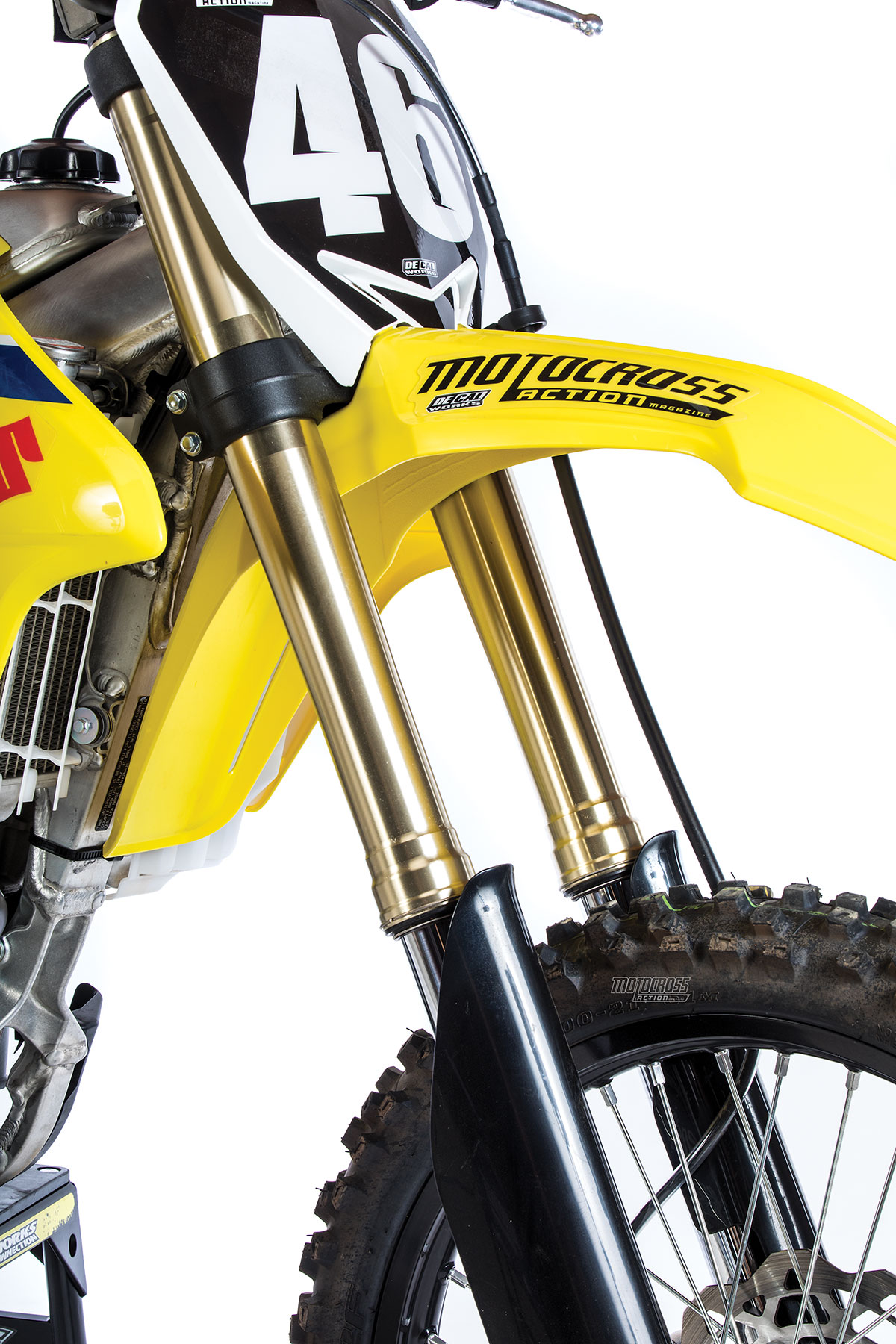 We like the low-pressure PSF-2 air forks. They have a standard air pressure of 35 psi. It was too stiff. We ran 32 psi.
We like the low-pressure PSF-2 air forks. They have a standard air pressure of 35 psi. It was too stiff. We ran 32 psi.
KAYABA PSF-2 FORK SETTINGS
Suzuki ran Showa SFF single-spring forks in 2013–2015, but for 2016–2018 they switched to Kayaba PSF-2 air forks. These forks work well for a wide range of riders. Most riders went down on the air pressure and out on compression. For hardcore racing, these are MXA’s recommended 2018 Suzuki RM-Z250 fork settings (stock settings are in parentheses):
Spring rate: 32 psi (35 psi)
Compression (bottom of fork): 10 clicks out (7 clicks out)
Hi-rebound (silver): 15 clicks out
Lo-rebound (red): 16 clicks out
Fork-leg height: Flush
Notes: Once you find the correct air-pressure setting for your weight, speed and track, focus on making all the adjustments with the compression clickers first, the low-speed rebound clickers second and high-speed rebound last. Given our druthers, we would prefer to have high- and low-speed compression damping instead of incremental rebound damping. If you want more straight-line stability, push the forks down into the clamps to the first line.
KAYABA SHOCK SETTINGS
Make sure to set sag. If it is not close to 105mm, it will throw everything off. For hardcore racing, these are MXA’s recommended 2018 Suzuki RM-Z250 shock settings (stock settings are in parentheses):
Spring rate: 5.5 kg/mm
Race sag: 105mm
Hi-compression (blue): 9 clicks out
Lo-compression (silver): 10 clicks out
Hi-rebound (bottom of shock): 17 clicks out
Lo-rebound (red): 11 clicks out
Notes: The 5.5 kg/mm spring might be a little stiff for minicycle transplants, but use free sag as your gauge. Check the race sag at regular intervals throughout the life of the machine. Don’t discount the shock when it comes to handling. If it is too stiff or the race sag too little, the RM-Z250 can go from a sweet-handling machine to a yellow ogre. Balance the front and rear with careful setup.
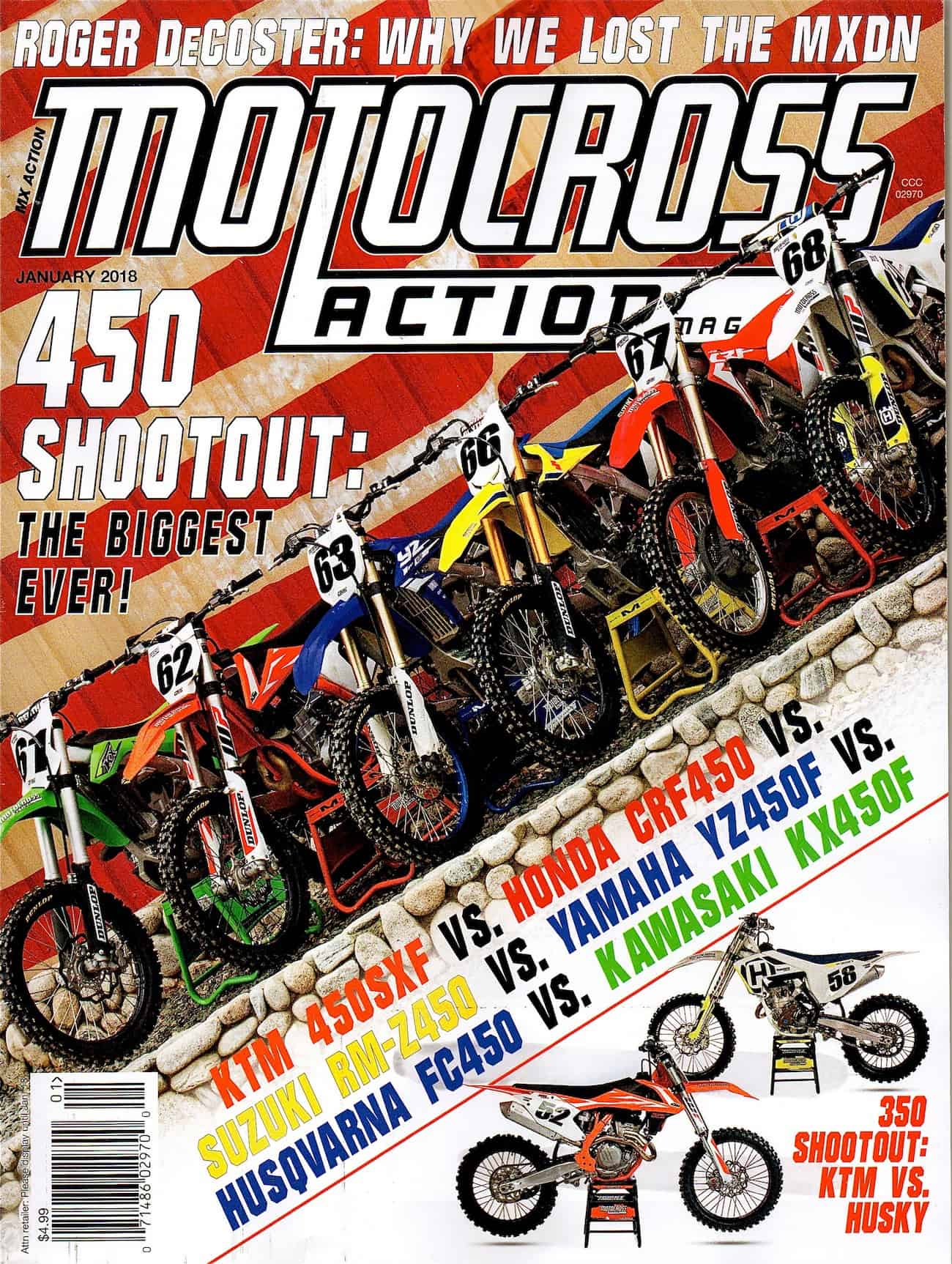 Had you subscribed to MXA, you would have read this complete bike test when in came out back in December. Click the box below to subscribe.
Had you subscribed to MXA, you would have read this complete bike test when in came out back in December. Click the box below to subscribe.



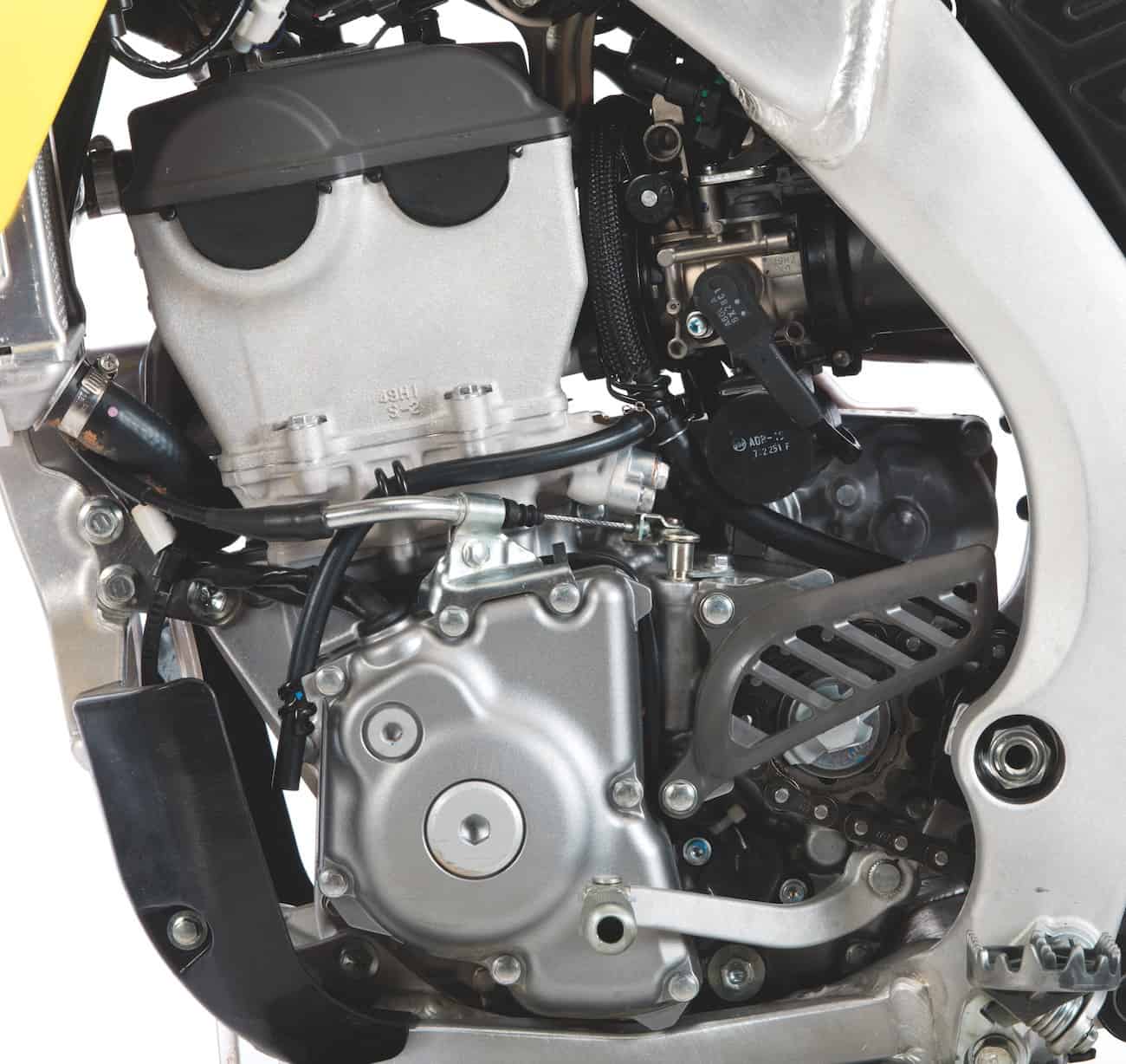


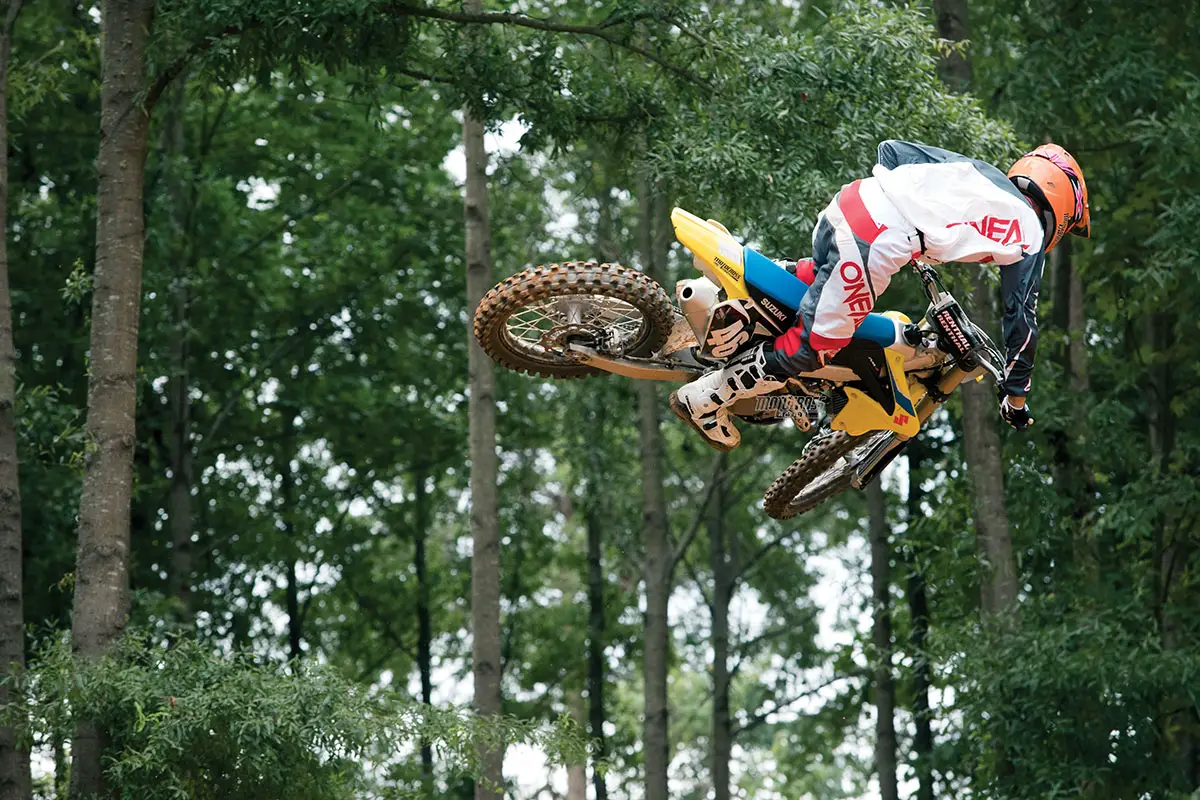

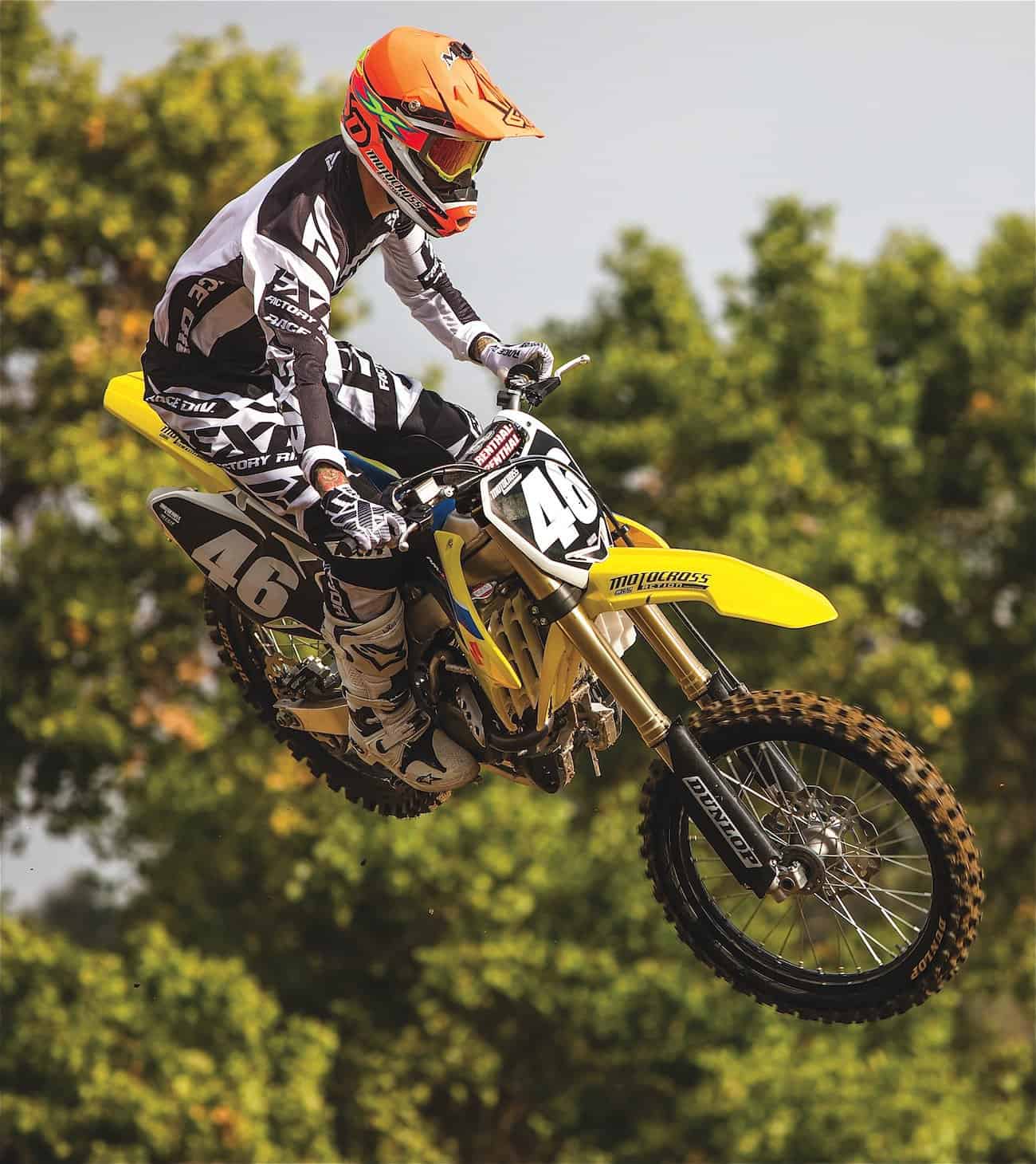





Comments are closed.